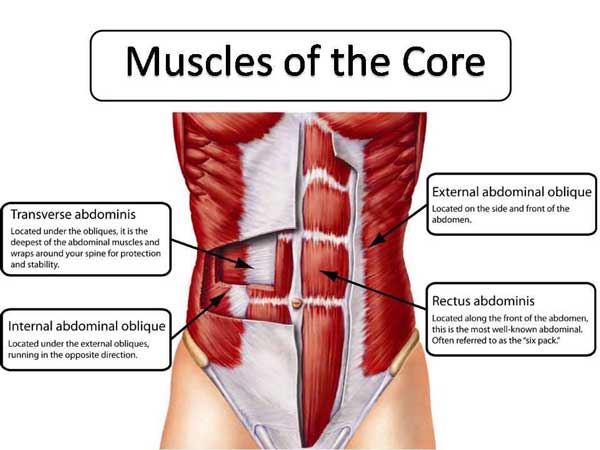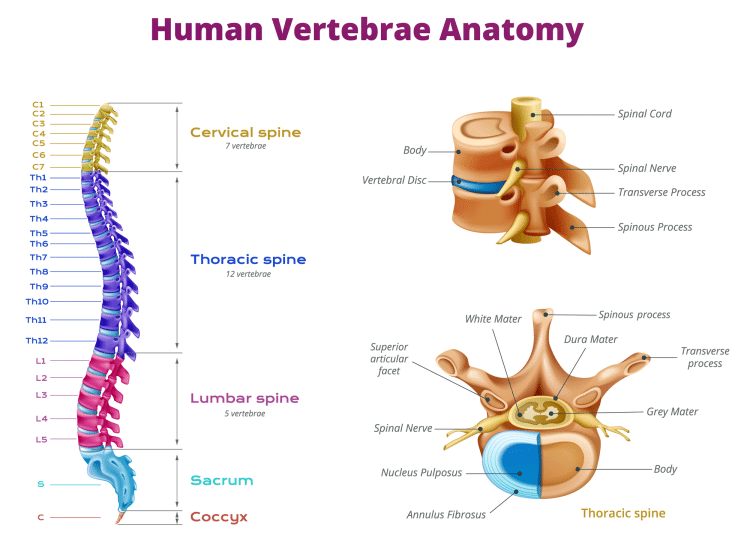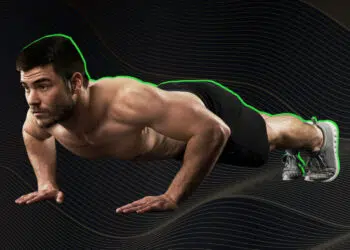When most people talk about core training or working out in general, they tend to mean exercises that involve movement. For the core, that means crunches, sit-ups, hanging leg raises, Russian twists, side bends, etc.
These exercises usually feature a concentric or shortening phase followed by an eccentric or lengthening phase. However, the core muscles work isometrically in many instances, generating force without changing length. They contract to prevent unwanted movement, which is what the term core stability means.
Training to prevent movement might seem odd, but it’s critical for various sports and activities in and out of the gym. For example, squats and deadlifts require incredible static core stability, as do overhead barbell presses, push-ups, and barbell curls.
Fitness experts call these static core strengtheners anti-core exercises. The anti refers to how the core muscles work to prevent movement rather than cause it.
Whether my personal training clients are prioritizing improved aesthetics, better performance, weight loss, or health, I make it a point to include anti-core exercises in their workouts. If nothing else, preventing unwanted lumbar spine movement could help stop lower back injuries.
In this article, I reveal the best anti-core exercises.
Level Up Your Fitness: Join our 💪 strong community in Fitness Volt Newsletter. Get daily inspiration, expert-backed workouts, nutrition tips, the latest in strength sports, and the support you need to reach your goals. Subscribe for free!
Recent Updates: On May 28, 2024, Fitness Volt’s Senior Editor, Vidur Saini (American Council on Exercise-CPT), revised the exercise list to include only the most effective anti-core exercises. We’ve also added actionable expert tips that you can implement immediately.
4 Best Anti-Flexion Core Exercises
Anti-flexion exercises emphasize your erector spinae muscles. These exercises are good for improving your posture and protecting your lower back from pain and injuries.
1. Back extension hold
| Sets & Reps | 3 x 30-60 seconds (Hold) |
| Equipment Needed | Back extension bench or GHD machine |
| Target Muscles | Erector spinae, glutes, hamstrings |
Anti-flexion exercises don’t come much simpler than the back extension hold. Done for time, this exercise teaches you to use your back muscles to resist the pull of gravity. Back extension holds are an excellent stepping stone onto more demanding exercises and is ideal for beginners.
“Beginners can hold their hands against their chests, whereas more advanced exercisers can hold them above their heads,” Saini recommends.
Steps:
- Mount your back extension machine (45-degree or horizontal) and get into the mid-point of the exercise so your body is straight.
- Brace your core and engage your glutes and hamstrings.
- Without holding your breath, maintain your position for as long as possible.
- Yes, all that shaking is perfectly normal.
- Relax, rest a moment, and repeat.
Benefits:
- Very easy to learn.
- Very accessible as most gyms have a back-extension machine.
- Easy to progress/regress by altering the time of each hold.
Coach Tips:
- Work up to holding for 2-3 minutes per rep.
- Make this exercise harder by holding a weight to your chest or using resistance bands.
- Keep your knees slightly bent throughout for comfort and safety.
2. Cobra Superman hold
| Sets & Reps | 3 x 30-60 seconds (Hold) |
| Equipment Needed | Exercise mat |
| Target Muscles | Erector spinae, glutes, hamstrings, shoulders, upper back |
No back-extension machine? No problem! You can work on your anti-flexion strength with this straightforward floor exercise. On the downside, it can be a little uncomfortable, so use a mat to avoid unnecessary pain.
Saini suggests maintaining a double chin by tucking your chin slightly to activate the deep neck flexors and enhance stability throughout the spine.
Steps:
- Lie on the floor on your front and place your hands behind your head.
- Lift your head, chest, arms, legs, and feet a few inches off the floor so you’re balancing on your abdomen and hips only.
- Hold this position for as long as possible.
Benefits:
- An ideal exercise for home workouts.
- No equipment required.
- Good for improving spine mobility.
Coach Tips:
- Place a folded mat under your hips for comfort.
- Take care not to hyperextend your spine.
- Do not hold your breath.
3. Dual kettlebell front rack carry
| Sets & Reps | 3 x 20-30 meters |
| Equipment Needed | Two kettlebells |
| Target Muscles | Core, shoulders, traps, grip strength |
While stationary exercises like back extension and Superman/cobra holds are effective, they don’t teach you to stabilize your spine during movement. As such, they’re good preparatory exercises, but you must also perform dynamic exercises for overall development. Dual kettlebell front rack carry trains you to resist flexion while moving your legs, so they’re much more functional.
Saini recommends keeping your elbows high and tight to your body, actively pulling the kettlebells into your chest to engage your lats and upper back for better posture and stability.
Steps:
- Rack and hold two kettlebells on your shoulders. Pull your shoulders down and back, and brace your core. Look straight ahead.
- Keeping your torso upright, walk around your training area until you start to tire.
- Lower the weights to the floor, rest, and repeat.
Benefits:
- A highly functional exercise.
- Good for integrating your core with your upper and lower body.
- An excellent general strength and conditioning exercise.
Coach Tips:
- Pick dumbbells instead of kettlebells if preferred.
- Use gym chalk for a better grip.
- Use one weight only to add anti-lateral flexion to this exercise.
4. Romanian deadlift
| Sets & Reps | 3-4 x 6-8 (strength) or 3-4 x 8-12 (hypertrophy) |
| Equipment Needed | Barbell or dumbbells |
| Target Muscles | Hamstrings, glutes, erector spinae, forearms |
While most people do RDLs to strengthen their glutes and hamstrings, it’s a very effective anti-flexion exercise. However, before attempting this exercise, you must be able to resist flexion in isolation first, e.g., with back extension holds.
“Keep the lowering phase slow and deliberate for optimal anti-flexion results,” Saini says.
Steps:
- Hold a barbell with an overhand, shoulder-wide grip. Stand with your feet between shoulder and hip-width apart, knees slightly bent.
- Brace your core and pull your shoulders down and back.
- Hinging from your hips, lean forward and lower the bar to the mid-shin level. Do noy round your lower back.
- Drive your hips forward, stand up straight, and repeat.
Benefits:
- An excellent exercise for your entire posterior chain.
- Easy to scale by adding or subtracting weight.
- A proven way to learn how to hip hinge, which is a prerequisite for many more demanding exercises, such as kettlebell swings and power cleans.
Coach Tips:
- Remove your shoes to keep your heels on the floor and your weight toward the back of your feet.
- Use chalk or lifting straps to reinforce your grip.
- Keep your chest up and your lower back slightly but tightly arched throughout.
Related: Romanian Deadlifts (RDLs) Guide
4 Best Anti-Extension Core Exercises
Anti-extension exercises target your rectus abdominis. Working on your anti-extension strength will lessen the likelihood of hyperextending your spine during athletic and everyday activities.
1. Plank
| Sets & Reps | 3 x 30-60 seconds (Hold) or 3 x Max Hold (Strength) |
| Equipment Needed | Exercise mat |
| Target Muscles | Core, shoulders, upper back, hip flexors |
The plank is the original anti-extension core exercise. With roots in yoga and Pilates, this exercise has existed for centuries. However, despite being so common, many people do this exercise incorrectly.
Saini suggests actively driving your elbows towards your toes and your toes towards your elbows, creating full-body tension and maximizing core engagement.
Steps:
- Kneel down and rest your forearms on the floor. Your elbows should be under your shoulders, lower arms parallel.
- Brace your core and pull your shoulders back and down.
- Walk your feet out and back to form a straight line with your shoulders and hips.
- Hold this position for the required duration. However, do not hold your breath.
Benefits:
- No equipment required.
- An excellent preparatory exercise for more advanced movements.
- An easy exercise to progress or regress.
Coach Tips:
- Try to increase muscle tension instead of holding for excessively long durations.
- Bend your legs and rest on your knees to make this exercise easier.
- Rest your forearms on a stability ball to make this exercise more challenging.
Related: Plank Progressions and Variations for Stronger Abs
2. Dead bug
| Sets & Reps | 3 x 10-12 reps per side |
| Equipment Needed | Exercise mat |
| Target Muscles | Rectus abdominus, core, hip flexors |
Dead bugs teach you to resist extension while moving your arms and legs, which is how your core muscles often have to work in real life. This is a highly functional anti-core move suitable for all exerciser levels.
“Exhaling sharply as you extend your arm and leg engages your TVA (transverse abdominis) to prevent your lower back from arching and maintain core stability,” said Saini.
Steps:
- Lie on your back with your legs bent and arms extended up toward the ceiling. Brace your core and press your lower back into the floor.
- Extend your left arm and right leg and lower them to the floor. Keep your lower back pressed down.
- Return to the starting position and repeat on the opposite side.
- Continue alternating arms/legs for the duration of your set.
Benefits:
- A very lower back-friendly exercise.
- A very functional anti-extension core exercise.
- No equipment required, so ideal for home workouts.
Coach Tips:
- Make this exercise easier by only lowering your arms OR legs.
- Make it more challenging by lowering both arms and legs together.
- Increase the intensity of this exercise by holding dumbbells or a medicine ball.
3. Overhead Pallof press
| Sets & Reps | 3-4 x 8-12 reps per side |
| Equipment Needed | Cable machine or resistance band |
| Target Muscles | Core, shoulders, obliques, lats, chest |
The Pallof press was invented by Bostonian physical therapist John Pallof. Unlike many anti-core exercises, this one uses weights to overload your muscles. As such, it can be progressed like any other strength-training exercise, i.e., by increasing the load. Unlike the traditional anti-rotation Pallof press, this is an anti-extension exercise.
Steps:
- Attach a rope handle to a high pulley. Grab the handle and then turn your back to the cable machine. Hold your hands at shoulder height. Brace your core and adopt a split stance for balance.
- Without leaning forward or backward, raise your arms above your head. Note how the tension on your core increases as you extend your arms.
- Lower your hands back to your shoulders and repeat.
Benefits:
- Can be made as easy or as challenging as required by adjusting the weight.
- Teaches you to integrate your upper and lower body with your core.
- A good exercise for improving shoulder mobility and stability.
Coach Tips:
- The narrower/closer your feet are, the more challenging this exercise becomes.
- You can also do this exercise with a resistance band.
- Experiment with different height cables to see what works best for you.
4. Rollout (Ab Wheel)
| Sets & Reps | 3 x 6-10 reps (to near failure) |
| Equipment Needed | Ab wheel |
| Target Muscles | Core, shoulders, lats, triceps |
Rollouts are like a moving plank. As you extend your arms, the tension on your core increases dramatically, and you’ll have to work harder to prevent lumbar spine extension. Rollouts also provide an intense lat workout. An ab roller is an excellent investment!
Saini urges rolling out as far as you can maintain a neutral spine, then slowly reversing the movement.
Steps:
- Kneel down and hold your roller with an overhand grip. Place the roller on the floor in front of your knees. Brace your core and pull your shoulders back and down.
- Push the roller out in front of you and lower your chest and abdomen down to the floor. Do not allow your lower back to extend.
- Using your abs and lats, pull the roller back up to your legs.
- That’s one rep.
Benefits:
- A low-tech exercise that’s ideal for home workouts.
- Can be modified to suit most exercisers.
- A challenging, effective anti-extension core exercise.
Coach Tips:
- Do this exercise from standing for a more intense workout.
- Don’t extend your arms so far to make this exercise less challenging.
- No ab roller? No problem! You can also do this exercise with a barbell.
Related: Rollouts: Benefits, Technique, And Alternatives
4 Best Anti-Lateral Flexion Core Exercises
Anti-lateral flexion exercises strengthen your obliques, rectus abdominis, and erector spinae muscles, albeit one side at a time. Improving your ability to resist lateral flexion will ensure you can keep your torso upright when dealing with unilateral or unbalanced loads.
1. Side plank
| Sets & Reps | 3 x 30-60 seconds per side (Hold) or 3 x Max Hold (Strength) |
| Equipment Needed | Exercise mat |
| Target Muscles | Obliques, rectus abdominus, erector spinae, deltoids |
The side plank is an excellent introduction to anti-lateral flexion exercises. It’s a little harder than front planks but just as simple to learn. This exercise is popular in group workout classes for a reason!
Elevate your top leg for an added challenge to the obliques and core, suggests Saini.
Steps:
- Lie on your side and rest on your forearm. Your body and legs should be straight. Brace your core.
- Lift your hips off the floor and hold them up for the required duration.
- Lower your hips back to the floor, roll over, and repeat on the opposite side.
Benefits:
- No equipment required, so ideal for home workouts.
- Easy to learn and master, so perfect for novice exercisers.
- An excellent preparatory exercise for more demanding anti-lateral flexion movements.
Coach Tips:
- Rest your elbow on a folded exercise mat or foam pad for comfort.
- Bend your legs to make this exercise easier.
- You can also do this exercise with your supporting arm extended:
2. Single-arm farmer’s walk
| Sets & Reps | 3 x 20-30 meters per side |
| Equipment Needed | Heavy dumbbell or kettlebell |
| Target Muscles | Core, grip, shoulders, traps |
Exercises don’t come much more functional than the single-arm farmer’s walk. However, despite its simplicity, this exercise can be extremely challenging. All you need is a single dumbbell, kettlebell, or heavy bag, so this exercise is ideal for home workouts.
Steps:
- Hold a heavy weight in one hand, arm by your side. Brace your core and make sure your hips and shoulders are level.
- Without leaning sideways, go for a walk around your training area.
- On completion, lower the weight to the floor, swap hands, and repeat.
Benefits:
- A highly functional core.
- Can be modified for all levels of strength by increasing or reducing the weight.
- An excellent way to develop a stronger, more enduring grip.
Coach Tips:
- Chalk your hands or use lifting straps to reinforce your grip if necessary.
- Walk in zigzags to destabilize the weight and make this exercise more demanding.
- Take care not to lean sideways or shrug your shoulders during this exercise.
3. Single-arm waiter’s walk
| Sets & Reps | 3 x 20-30 meters per side |
| Equipment Needed | Light-medium dumbbell or kettlebell (held overhead) |
| Target Muscles | Shoulders, core, traps |
The single-arm waiter’s walk is similar to the farmer’s walk, but the weight is held overhead and not down by your side. This increases the stability demand of this exercise. Take care not to go too heavy too soon with this exercise; it’s harder than it looks!
Saini suggests focusing on pushing the weight directly overhead, creating space between your ear and shoulder to activate your serratus anterior and stabilize the shoulder joint.
Steps:
- Lift and hold a single dumbbell or kettlebell overhead. Brace your core and engage your shoulders and upper back to stabilize the load.
- Without leaning sideways, go for a walk around your training area.
- On completion, lower the weight to the floor, swap sides, and repeat.
Benefits:
Level Up Your Fitness: Join our 💪 strong community in Fitness Volt Newsletter. Get daily inspiration, expert-backed workouts, nutrition tips, the latest in strength sports, and the support you need to reach your goals. Subscribe for free!
- A challenging and effective anti-lateral flexion exercise.
- Builds stronger, more stable shoulders.
- Can be modified for all levels of strength by increasing or reducing the weight.
Coach Tips:
- Walk in zigzags to make this exercise more demanding.
- Avoid leaning sideways during this exercise.
4. Single-arm overhead press
| Sets & Reps | 3-4 x 6-8 (strength) or 3-4 x 8-12 (hypertrophy) per side |
| Equipment Needed | Dumbbell or kettlebell |
| Target Muscles | Obliques, rectus abdominus, erector spinae, deltoids |
Overhead presses are great for building bigger shoulders and triceps. However, when you switch from using both arms to just one, they become an excellent ant-lateral flexion exercise. Requiring just one weight, this anti-core move is ideal for home workouts.
Saini recommends using your core and leg drive to generate power and lift heavier weights.
Steps:
- Hold a dumbbell or kettlebell in one hand at shoulder height. Stand with your feet shoulder-width apart and brace your core.
- Make sure your hips and shoulders are level.
- Without leaning sideways, press your weight up and overhead to arm’s length.
- Lower the weight back to your shoulder and repeat.
- Switch hands and do the same number of reps with your other arm.
Benefits:
- A very functional upper-body and core exercise.
- An excellent way to identify and fix left-to-right strength imbalances.
- A very accessible, practical exercise.
Coach Tips:
- Do this exercise in front of a mirror to ensure you’re keeping your shoulders level.
- Use less weight than you would for a two-handed overhead press.
- You can also do this exercise with a barbell, which is called the javelin press:
3 Best Anti-Rotation Core Exercises
Anti-rotation exercises target your obliques. Having stronger obliques will help you prevent unwanted twisting during activities like running, kicking, and throwing. Anti-rotation is especially important during contralateral activities where you use one arm and the opposite leg, e.g., running.
1. Bird-dogs
| Sets & Reps | 3 x 10-12 reps per side |
| Equipment Needed | Exercise mat |
| Target Muscles | Obliques, rectus abdominis, gluteus maximus, hamstrings, deltoids, erector spinae |
Bird-dogs are one of the most basic anti-rotation exercises around. This exercise teaches beginners how to stabilize your core as you move your arms and legs. Bird-dogs are also an excellent muscle activation exercise and are perfect for warm-ups.
Steps:
- Kneel on all fours with your shoulders over your hands and your hips over your knees.
- Brace your core and set your shoulders down and back.
- Keeping your hips and shoulders level, extend your right arm and left leg.
- Lower them back to the floor and repeat.
- On completion of your set, swap sides and do the same number of reps with the opposite arm and leg. Or, if preferred, you can use an alternating arm and leg action.
Benefits:
- An excellent exercise for people with lower back pain.
- A great movement for beginners.
- No equipment required, so ideal for home workouts.
Coach Tips:
- Kneel on a folded exercise mat for comfort.
- Use ankle/wrist weights to make this exercise more challenging.
- You can also do this exercise in a high plank position like this:
2. Pallof press
| Sets & Reps | 3-4 x 8-12 reps per side |
| Equipment Needed | Cable machine or resistance band |
| Target Muscles | Core, obliques |
The Pallof press is one of the most widely performed anti-rotation core exercises. Popular with almost every type of exerciser, it’s safe to say that this move delivers. If you’ve never done Pallof presses before, you are in for a treat, but if you’re already doing them, you should definitely continue!
“Resist the rotation by actively pushing your hands away from your body, creating tension in the obliques and challenging your core stability,” says Saini.
Steps:
- Attach a D-shaped handle to a cable machine set to mid-chest height.
- Stand side-on to the pulley and hold the handle with both hands.
- Your feet should be about shoulder-width apart, with your knees slightly bent. Brace your core.
- Pull your hands into your chest and step away from the machine to engage the weights.
- Without moving your hips or shoulders, extend your arms out in front of you. Feel how the tension on your muscles increases as you straighten your arms.
- Bend your elbows and return your hands to your chest.
- Repeat for the required number of reps and then switch sides.
Benefits:
- An ideal exercise for beginners.
- A very spine-friendly anti-core exercise.
- Very scalable — just adjust the load to reflect your current strength.
Coach Tips:
- You can also do this exercise with a resistance band.
- Hold your hands at different heights to work your core from different angles.
- Try doing Pallof presses in a half-kneeling position for variety, like this:
3. Renegade row
| Sets & Reps | 3-4 x 8-12 reps per side (to near failure) |
| Equipment Needed | Two dumbbells, exercise mat |
| Target Muscles | Core, back, shoulders, biceps |
Renegade rows are among the most challenging anti-rotation exercises, even with light to moderate weights. However, if you’ve mastered Pallof presses and can do bird-dogs in your sleep, this is the exercise you’ve been waiting for!
Your hips and shoulders should remain square throughout the exercise, cues Saini.
Steps:
- With a dumbbell in each hand, squat down, and place them on the floor.
- Walk your feet out into the push-up position. Brace your core and tense your legs.
- Bend one arm and row the dumbbell up and into your lower ribs.
- Lower the weight back to the floor, switch arms, and repeat.
- Alternate arms for the required number of reps.
Benefits:
- A total core exercise that teaches you to stabilize your core as you move your arms and legs.
- A time-efficient conditioning exercise that burns lots of calories.
- A challenging movement that’s ideal for intermediate and advanced exercisers.
Coach Tips:
- Wear a weighted vest to make this exercise even harder.
- Use hexagonal dumbbells for increased stability and safety.
- Combine renegade rows with push-ups for a complete upper-body and core workout:
Related: Renegade Rows Guide
Core Anatomy Basics
Core is the collective term for the muscles that encircle your midsection. Some fitness folk also like to include other muscles in the core, such as the glutes and lats, but that just confuses matters. So, for the purposes of this article, the core is the muscles in and around the abdominal region.
The primary muscles that make up the core are:
Rectus abdominis
Located on the front of your abdomen, the rectus abdominis is the large, flat muscle that, when you are lean, has that unique six-pack appearance. The rectus abdominis is responsible for the flexion of your spine and also contributes to lateral flexion.
In anti-core terms, the rectus abdominus prevents extension and lateral flexion of the spine.
Obliques
The obliques are essentially your waist muscles. There are two sets of obliques on each side of your abdomen — internal and external. They work together to rotate and laterally flex your spine.
In anti-core terms, the obliques prevent rotation as well as initiating it.
Transverse abdominis
Known as the TVA for short, this muscle surrounds your abdominal contents like a corset or weightlifting belt. It contracts inward to increase intra-abdominal pressure, stabilizing your spine from within.
If prizes were being given for the most critical anti-core muscle, the TVA would be a shoo-in for the gold medal!
Erector spinae
Erector spinae is a group of muscles that run up either side of your spine, including the iliocostalis, longissimus, and spinalis, each of which can be subdivided into three further sections. The erector spinae are responsible for extending your spine as well as lateral flexion.
In anti-core terms, the erector spinae prevents flexion and lateral flexion.
Movements of the spine
The spine is a column of 33 individual bones called vertebrae. It’s divided into five sections:
- Cervical spine – your neck – made up of 7 vertebrae
- Thoracic spine – your upper back – made up of 12 vertebrae
- Lumbar spine – your lower back – made up of 5 vertebrae
- Sacrum – part of your pelvis – made up of 5 immovable/fused vertebrae
- Coccyx – your “tailbone” – made up of 4 immovable/fused vertebrae
The cervical, thoracic, and lumbar vertebrae are separated by intervertebral discs, which are sections of tough fibrous cartilage. These discs absorb shock and compress to allow movement.
Speaking of which, the spine is capable of four main movements:
- Flexion, i.e., bending forward
- Extension, i.e., bending backward
- Lateral flexion, i.e., bending sideways
- Rotation, i.e., twisting
Movements can also be combined, e.g., flexion with rotation during a twisting crunch.
As such, there are four groups of anti-core exercises, each one designed to prevent one (or more) of these movements. For example, anti-extension exercises emphasize the rectus abdominis, while anti-rotation exercises emphasize the obliques. However, all anti-core exercises involve the transverse abdominis.
Benefits and Drawbacks of Anti-Core Exercises
Not sure if you need to include anti-core exercises in your workouts? Consider these benefits and then decide:
Very functional
Functional training is a very misused term. Many people confuse functional training with technically demanding exercises involving a lot of balance, e.g., squats on a stability ball or curls while slacklining. While these are impressive feats, they’re not examples of real functional training.
In contrast, functional training means doing exercises that have a carry-over to your life outside of the gym, i.e., they improve how you function.
Anti-core exercises train your midsection in a very functional way. People often have to use their core muscles this way during their daily lives, in the gym, or on the sports field. Anti-core exercises will have a significant carry-over to your everyday life.
Spine-friendly
Like any joint, the spine is prone to wear and tear. If you do a lot of crunches, sit-ups, Russian twists, etc., you can cause stress to both the vertebrae and intervertebral discs, and these structures can become worn and damaged.
By their very nature, anti-core exercises involve no movement, so there will much less stress on your vertebrae, spinous ligaments, or discs. In fact, anti-core exercises should not cause lower back stress or pain of any sort – done correctly, of course!
Easy to learn
With no movements to think about, most anti-core exercises are very straightforward and easy to learn. You just have to keep still and prevent movement. That’s not to say these exercises are easy — far from it. However, from a technical performance perspective, the learning curve for most anti-core exercises is pretty short.
While anti-core exercises are mostly beneficial and safe, there are also a few drawbacks to consider:
Usually done for time instead of reps
Many anti-core exercises are held for a predetermined time, e.g., 30 seconds. This means you’ll need to use a timer or be able to see a clock with a second hand. Also, some people prefer to pump out reps, and keeping still may be less appealing.
Elevated blood pressure
Isometric anti-core exercises can cause a short-term increase in blood pressure (1). This is because the muscles are contracted, which reduces blood flow. This should be no issue for people with healthy blood pressure but could be problematic for anyone with hypertension.
This problem can be reduced by never holding your breath during anti-core exercises. Breath-holding can have a significant effect on blood pressure.
Speak to your doctor if you have high blood pressure before doing any of the exercises in this article.
FAQs
1. How many reps and sets should I do?
There is no magic number of reps you should use to train your core. You will make progress whether you do 10 or 30 reps per set. That said, lower reps are generally more time-efficient, so it’s worth choosing exercises that are demanding enough to fatigue your muscles relatively quickly, e.g., between 12-20. Wherever possible, avoid very high-rep sets, e.g., 50.
In terms of sets, 3-5 should be sufficient for most people. If you can do more, the chances are that you a) aren’t getting close enough to failure or b) are resting too long between efforts.
2. How often should I do anti-core exercises?
It’s generally accepted that it takes 48-72 hours for a muscle or muscle group to recover from a workout. As such, you should aim to do anti-core exercises 2-3 times per week on non-consecutive days, e.g., Monday and Thursday, or Monday, Wednesday, and Friday. This provides a good balance between work and recovery.
Training your core more often, i.e., daily, won’t necessarily produce better results, and could even lead to overtraining.
3. Will anti-core exercises give me a six-pack?
While doing anti-core exercises will develop your six-pack muscle (the rectus abdominis) and other critical core muscles, you won’t be able to see them until your body fat percentage is low enough. This usually means under ten percent for men and 15 percent for women.
It’s true what they say — six-pack abs are made in the kitchen, and your diet will determine if your abs and core muscles are visible.
4. Are anti-core exercises safe?
Because they involve minimal movement, most anti-core exercises are very safe. As long as you brace and stabilize your spine correctly, there should be very little stress on your intervertebral discs or spinous ligaments, so many are even okay for folk who suffer from back pain.
That said, exercises that involve additional movements, e.g., single-arm overhead presses, are somewhat riskier than static exercises like planks and side planks.
However, if performed correctly and with appropriate loads, there is a very low risk of injury with most anti-core exercises.
5. Do I have to do anti-core exercises? Aren’t regular core exercises enough?
While all core exercises are beneficial, anti-core exercises are often more functional. That’s because you often need to use these muscles to prevent unwanted movement of your lumbar spine, e.g., during deadlifts, push-ups, and overhead presses.
If your core is strong, you may not need to do a lot of anti-core training. However, if your lumbar spine lacks the stability it needs, then anti-core exercises are a must.
Wrapping Up
Whether you’re training for performance, aesthetics, or health, your workouts should include anti-core exercises. Anti-core exercises teach you how to stabilize your lumbar spine, which will protect you from lower back injury.
A more stable spine will also let you do more reps with heavier loads, making the rest of your workout more effective.
With 15 anti-core exercises to choose from, you have more than enough options to keep you busy and progressing for years to come. Include anti-core exercises in all your midsection workouts for best results.
References:
- Hanson P, Nagle F. Isometric Exercise: Cardiovascular Responses in Normal and Cardiac Populations. Cardiol Clin. 1987 May;5(2):157-70. PMID: 2884033. https://pubmed.ncbi.nlm.nih.gov/2884033
Interested in measuring your progress? Check out our strength standards for Push Ups, Barbell Curl, Sit Ups, and more.











